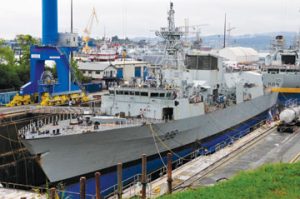The art of “balancing” a warship
By Lookout on Apr 30, 2012 with Comments 0
To do this, they had to perform an inclining experiment at the end of March to measure the ship’s vertical centre of gravity of it’s “as is” condition.
“Whether it’s a B.C. Ferry or a tanker at sea, naval architecture like this must be done on the ship to determine if it is safe to sail,” says FMF engineering design technologist, Brian Hutchinson.
Riggers and crane operators prepped the experiment by manoeuvring four 5,500 kilogram concrete weights and two sets of pendulums on board.
Once the massive weights were on board, the brow was lifted and tugs gently nudged the frigate away from the jetty allowing it to float freely in the water about 10 metres away, but still in crane’s reach.
The wind was measured with a hand held anemometer.
“Weather conditions were very important for this experiment,” explained Hutchinson. “We can’t have wind speed over five knots. We need flat wind conditions or we won’t get an accurate reading.”
The wind velocity was deemed appropriate for the experiment. The sea state was flat, and all boat traffic into the harbour was minimized while the experiment was underway.
“We literally lifted up the weights in a prescribed order with the crane and took them from the port to the starboard side to get the vessel to list. Because we had pendulums forward and aft in the ship, we could measure and calculate the amount of weight that it would take the ship to heel over to what would be considered an unsafe condition,” says Hutchinson.
Docking Officer Golam Morshed called the shots, while riggers lifted in harmony with the crane operators, and shipwrights took readings of all four marks in three intervals. Those were used to determine the list and trim of the ship by Morshed for his calculations.
Hutchinson says this experiment is conducted many times over the course of a ship’s life because it becomes lighter or heavier as new equipment is put on and old equipment taken off, and everytime a ship has gone through a refit
After the experiment, the boat travelled across the harbour to Victoria Shipyards for its midlife refit and continued modernization.
The experiment itself took most of the morning to complete and involved about 65 workers.
“After the experiment there was a lot of number crunching and days spent on computers to arrive at the proper calculations,” said Hutchinson.
After Winnipeg is finished its FELEX refit, it will undergo another inclining experiment prior to sailing back across the harbour.
Shelley Lipke
Staff Writer
Filed Under: Top Stories
About the Author:






